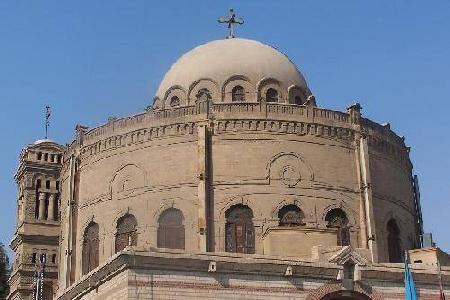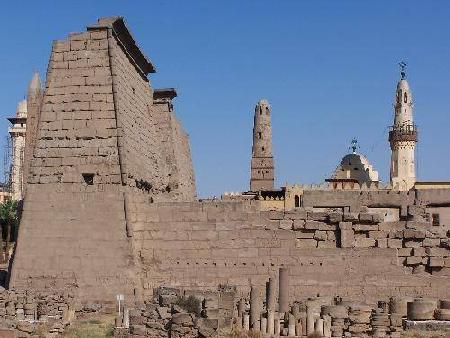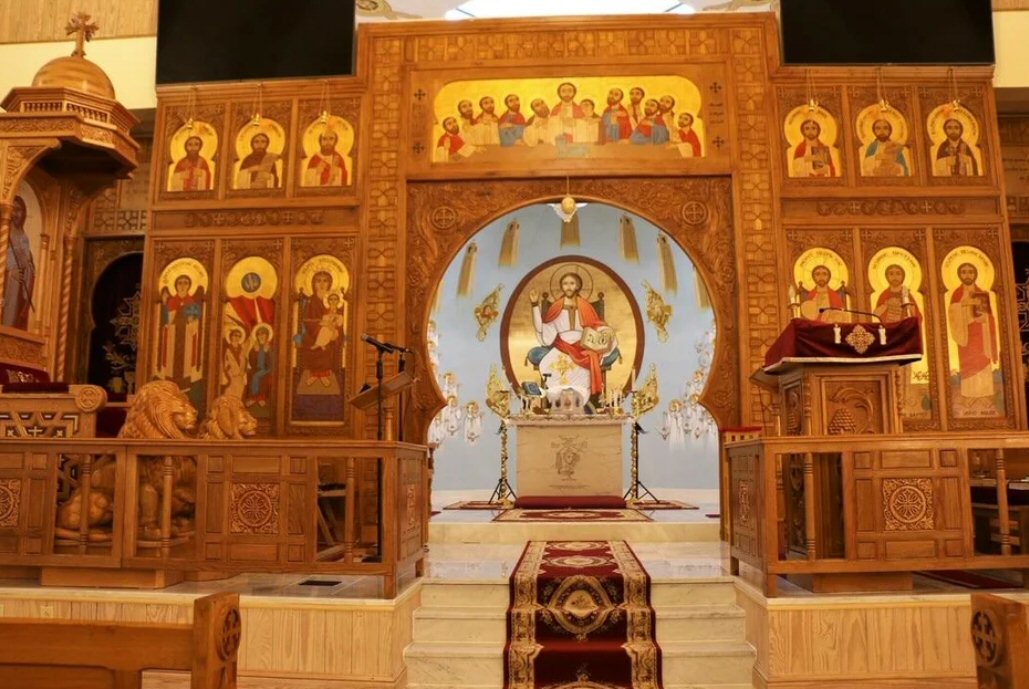At th end of of the potolemaic era the local egyptain were known as Aegyptioi, from the toponym Aegyptos (Egypt). The Word Aegyptos itself is derived from the ancient name of the capital Memphis, Ha ka Ptah,'the house of the soul of Ptah,'Which was the main deity of the pantheon of Memphis, the ancient capital and thus of the hole country. Removing the aspired H, confusing between k and g and finally adding the os greek syllabus, we have the word Aegyptos. When the Arabs conquered Egypt in AD 641 the name Aegyptioi was transcribed in the Arabic alphabet, which lacks vowels and the letter 'p.' The word thus became Qbt, pronounced qibt, from where the word 'Copt' is derived. Since then the word Qbt is used to indicate the local population of Christian religion, Though since its origins it refers to the Egyptian in general.
The Coptic Orthodox Church
With the death of Constantine, the Roman Empire had been divided into two parts: the Eastern part and the Western one. The Western Roman Empire collapsed due to the German invasions. While in the Eastern Roman Empire, a new Greek-Christian civilization (the Byzantine) flourished. In Egypt, the Coptic Civilization emerged with its special new personality representing a mixture between the Greek and local Egyptians. Remarkably, Egypt depended on this Eastern Empire. Like its predecessors, Egypt, at that time, had a dual character: it was officially Byzantine but Coptic on both the local and provincial levels.
The Coptic Orthodox Church of Egypt was founded in the name of Jesus in the first century and still bears witness to the name of its Lord. It is named the "Coptic Church", according to its nationality and "Orthodox" according to its creed. The name "Orthodox" is a compound word - Ortho Doxa - which means "Original Faith". This title was given to the Coptic Church, because it defended the old creed against several attacks, which were made upon it during succeeding centuries. The Christians of Egypt, Sudan and Ethiopia now follow the creed of the Coptic Church.
Brief History of Coptic Church

Egypt is one of the first evangelized countries: in 60 AC, San Marcos came in Alexandria to predicate the faith and he was martyred in 68 AC by an attack of the pagans. Hit by the Roman occupation, the continuous civil wars between the Greeks and the Jews, the emergence of the new class of the Greco-Egyptians and the emergence of the nationalist spirit with the Egyptian revolutions in Delta, many Greek-Egyptians embraced the new faith which predicated fraternity and redemption. They easily adopted the new religion thinking that the new religion had much resemblance with their Holy Trinity and its values: redemption, salvation, resurrection, passive resistance and equity between humans. During the reign of Diocletian, the new Christian Religion put obstacles in the way of materializing his project to revive the Empire. Christianity had spread in the Delta between the Greco-Egyptians and gradually spread to Alexandria. Diocletian ordered the persecution of Christians and massacred thousands of them, so the year of his coronation is considered the year of the martyrs and the beginning of the Egyptian Coptic Calendar. Persecutions continued almost unceasingly: churches were pulled down, the Holy Scriptures were burnt, Christian literature was destroyed, the Christians were dismissed from all state services, the Christian property was confiscated and they were deprived of their national rights through allowing the unbelievers to persecute and torture them. It would be impossible to enumerate even a reasonable selection of the martyrs of that era. The Coptic Synaxaire (a compilation of the biographies of saints and martyrs for all the days of the year) and the "Lives of Saints" are full. Alexandrine Christianity became the tight of the world. The venerable Fathers of the Coptic Church, the great theologians of the Catechetical School of Alexandria, the Coptic Saints and heretics, the founders of monasticism, the immortal leaders of the ecumenical movement, all these and numerous other categories of illustrious Copts made indelible contributions to the establishment of the new faith.
St. Mark The First Patriarch of the Coptic Church of Alexandria

The Copts pride themselves on the apostolicity of their national church. whose founder was St. Mark (martyred during Nero's reign [54-68 A.D.], in 68) one of the four Evangelists and the author of the oldest canonical Gospel used by St. Matthew and St. Luke, probably also St. John. Saint Mark is regarded by the Coptic hierarchy as the first in their unbroken chain of 116 patriarchs. He is also the first of a stream of Egyptian saints and glorious martyrs. The History of the Patriarchs of the Coptic Church of Alexandria compiled in Arabic from ancient Coptic sources and continued by Sawiris ibn al-Muqaffa, bishop of al-Ashmunain in Middle Egypt, begins with an elaborate biography of the Evangelist and first patriarch. The martyrdom of St. Mark was in fact a spontaneous act of violence committed by the enraged pagan populace. The belieevers took his body and buried it in the Church of Bucalia, which is situated along the coasts of Alexandria. This was the first church founded in Egypt,
The Catechetical School of Alexandria
The Catechetical School of Alexandria A residential building in Beni Suef Most of the eminent leaders of Alexandrine Christianity are known to have been connected with the School, either as teachers or students. In fact, the history of that school may be summed up in the biographies of the personalities who headed it, and whose contributions to theological scholarship still constitute the solid basis of any study of Christian the bishops by calling him " Papa ". This means that the first prelate in Christendom to bear the title of pope was Heraclas the Copt, during the early part of the third century, long before the title was known to Rome. The first great name to emerge at the head of that school was Pantrenus. He was an inhabitant of Alexandria. The Copts describe him as a citizen of Egypt. At some time in the course of his service, Patriarch Demetrius II elected him for the Christian mission to India, and he is known to have undertaken this after finding a worthy substitute to head his school. The teachers of the catechumens were generally presbyters and deacons. They were called "catechists". The Catechetical School was, on the one hand, a bulwark of the A wall relief in the Tomb of Petosiris, depicting a mummy Church against unworthy members, and on the other, a bridge from the world to the Church. The catechumens were people of all ranks, ages and grades of culture, even philosophers, statesmen and rhetoricians. So Christian education began as uniform and universal, without discrimination between classes or conditions, slaves or masters. The catechumens were c1assified into three groups, which were only stages in the process of instruction : The Inquirers: This class consisted of those whose interested in Christianity had been sufficiently aroused to make them desire further information. They received private and individual instruction from the teacher bef ore they were admitted into the second class. The Audientes or the Hearers : are those who were admitted into the church to listen to the Scriptures and sermons. They were allowed to attend the part of the Mass known as the "Mass of the Catechumens". They were dismissed immediately after the sermon. The Competents: are those who were qualified for baptism and could attend a part of the prayer. They could not partake of the sacrament. In the earliest period of the church, persons were often admitted after very brief preparation; but, in the Panoramic view of Talaat Harb Square and some remarkable buildings in it second century, a period of probation and instruction was deemed essential. Usually the candidates applied for baptism at the beginning of Lent and looked forward to baptism at Easter. By the middle of the third century, there arose the system of discipline commonly lasting for three years, according to the Apostolical Constitutions. The Catechetical School of Alexandria flourished and established a great reputation in the Church Universal. It furnished the candidates for baptism and believers with an elementary Christian education. Yet the Christians of Alexandria were anxious to grow in the Christian knowledge and experience and to struggle scientifically and philosophically against the attacks of the pagan philosophers, and to compete with the pagan school of Alexandria (Museion).
Clement of Alexandria
Clement of Alexandria , who was the most illustrious of the pupils of Pantrenus, succeded him. He became head of the school before 190, and died around the year 215 Clement wrote abundantly, though much of his work is lost. His erudition is especially revealed in the series of discussions whereby he attempted to reconcilc Greek culture and Christianity. He is rightly regarded as one of the earliest apostles of Christian liberalismo.
Origen
Origen followed Clement about the year 215, and died about 254. As a biblical scholar and philosopher, his erudition was massive and his creativity colossal. Origen, like most prolific writers and universal thinkers, became a controversial figure both in his lifetime and after his death.
Heruclas
Herruclas,the former pupil and assistant of Origen, succeded him. Herruclas followed Demetrius in the episcopate from 230 to 246. It is said that when he increased the number of his Local bishops to twenty, the presbyters of the Church decided to distinguish him from the rest of The Catechetical School of Alexandria was undoubtedly the earliest important institution of theoological learning in ~hristian antiquity. Its members were responsible for the formulation of the first systems of the Christian theology and some of the most monumental works of exegesis. Yet it would be an error to limit its curriculum to theology. It was a college which comprised many other disciplines, including the humanities, science and mathematics - although its chief function in the age of faith - was religion. The eartiest known reference to it occurred during the tife of Pantrenus, who died about 190 A.D. From that time on it was eondueted parallel to the older but pagan Museion, until the latter began to dwindle and was ultimately liquidated in 415.
Dionysius of Alexandria
The next head of the school, after Herruclas, another famous pupil of Origen, was Dionysius of Alexandria, later sumamed the great. He occupied that post until he became patriarch (246-264). His reign was so full of troubles that it is a wonder he had time to compose a number of theological works, in which he displayed an independent, but rather controversial. mind. He rejected the heretical innovations of Paul of Samosata, Bishop of Antioch and wealthy procurator of Queen Zenobia of Palmyra.
Didymus
Athanasius the' Apostolic entrusted Didymus the Blind to head the school, from about 315 to 398. He lived during the tempestuous age of Arianism and the Council of Nicea. Amongst his pupils were St.Gregory Nazianzus, St. Jerome and the historian Rufinus. It is interesting to know that he cared for the welfare of the blindd, as he had been blind from the age of four - by promoting a system of embossed or engraved writing for them, for the first time' in history. After Didymus, we enter the dark period in the history of the School, and our knowledge of its, role or even its very existence tapers. lt had done its share in shaping Christian doctrine and theological scholarship in those formative years. Then the zeal and the knowledge began to fade, and within them a great institution.
The Second Persecution

The pagan persecution did not only contribute to the spread of Christianity, but also its unity. Well, as soon as the new religion was recognized as an official religion of the Roman empire, theological differences broke out,causing wars and persecutions. Constantine hold the Nikaia forum in the year 325 to bridge differences between Arius and Bishop Athanasius of Alexandria. The outcome of the forum was disastrous because, initially Arius was sent to exile and, then Athanasius and thus sowed divisions among the Eastern churches and was the beginning of the conflict between the state that wanted to control the church and the church that claimed that old previlegies of ancient pagan temples. After the death of Constantine the empire was divided, and Egypt depended to the orintal or Byzantine empire. In the times of Alens, who were a fanatic asdipt of Arius, again the Egyptian suffered the persecution and Athanasius was assassinated. Christian Egyptians had to flee to the desert and groots where they founded the first monasteries in the world. After The death of Valens, Theodosius declared Christianity , the only official religion of the empire and a new persecution began; The persecution and destruction of pagans and their temples. At the Council of Chalcedon, the Egyptian Church was isolated from the western church and Christianity was divided into three churches: The Egyptian and the Syrian called the orthodox or Jacobite; The roman church called the catholic and the Church of Constantinople called the Malakite.
The Copts and the Spread of Islam

Islam Recognizes Jesus as a prophet and his mother as Holy Virgen. Mohammed -the Prophet of Islam-, who had an Egyptian wife named "Coptic Maria" (mother of Ibrahim his son), preached especial kindness towards Copts: "When you conquer Egypt, be kind to the Copts for they are your proteges and kith and kin". For these reasons and the four centuries that followed the Arab's conquest of Egypt, the Coptic Church generally flourished and Egypt remained basically Christian. Copts, thus, were allowed to freely practice their religion and were to a large degree autonomous, provided they continued to pay a special tax, called "Gezya", that qualifies them as "Ahl Zemma" proteges (protected). Copts, despite additional sumptuary laws that were imposed on them in 750-868 A.D. and 905-935 A.D. under the Abbasid Dynasties, prospered and their Church enjoyed one of its most peaceful era. This continued, untill the The Crusaders, when the Copts and the syrian, under the arabic rule found themselves in critical situation.
Coptic Faith
The Coptic Church believes in one nature of God. The Coptic Orthodox Church professes that the union of the Word of God with the flesh is as the union of the soul with the body, and as the union of fire with iron, which although they are of different natures, yet, by their union, become one. This nature is neither merely the Godhead, nor the Manhood alone. It is the one nature, which has the properties of the two natures with neither mixture, nor confusion or alteration. Jesus is perfect in His Godhead and perfect in His Manhood. For the Copts, Jesus is God Incarnate.
The Sacraments
The Coptic Church recognizes Seven Sacraments: Baptism Chrismation (Confirmation), Holy Eucharist, Penance, Holy Orders, Matrimony and Unction of the sick. The Church professes that in the Holy Eucharist, the elements of bread and wine are transubstantiated, at the Consecration, into the very Body and Blood of Jesus Christ. The Church venerates, above all, the Saints and the Virgin Mary.
The Holy Order
The Coptic Church recognizes seven Holy Orders: Reader, Sub-Deacon, Deacon, Archdeacon, Priest, Hegoumenos (Archpriest or Abbot) and Bishop. Candidates for ordination to the parish priesthood must be married, since marriage is forbidden after ordination. At present, the See of Alexandria comprises twenty-eight dioceses and bishoprics in Egypt, one for Jerusalem and Middle East, two for the Sudan, and one for Johannesburg (S.A.). The Church of Ethiopia is a daughter Church of the Coptic Church. But since 1959, it has had the right to nominate its own supreme head, who must be consecrated by the Patriarch of Alexandria. The Patriarch of the Coptic Church is ipso facto Bishop of Alexandria. The official title of the Patriarch of the Coptic Church is: "Our Most Holy and Most Blessed Father, Pope Abba, Patriarch of the Great City of Alexandria and of all the Land of Egypt, of the City of our God, Jerusalem, of the Pentapotis, of Libya, Nubia, Ethiopia and Africa." In a Coptic church, ladies are not obliged to cover their heads, but they may not – under any circumstances – enter into the sanctuary which lies behind the screen. Men, on the other hand, may do so, but they should first take off their shoes, as the space round the altar is considered a holy ground.
The Horologion
The Seven Prayers set by the Church and first started by St. Pachom are: Moming (said at dawn), Terse (recited about nine in the morning), Sexte (sung at midday), None (sung about 4 pm), Vespers (sung at sunset), Compline (or the Prayer before sleep), Matins (sung at midnight and comprises of three groups, each said within an hour of the other). Each of these prayers comprises twelve Psalms (with the exception of Moming and Mattins) followed by a set of Church prayers. The Church Services on Sundays and Feast Days are: the Evening offering of Incense preceded by the recitation of None (except on fast days), Vespers and Compline. The Morning offering of Incense is preceded by Mattins and Prime and is followed by Terse, Sexte (and None on fast days) and the Divine Liturgy. Leavened freshly-baked bread is used for the Holy Eucharist, and Holy Communion is administrated under both kinds, the Holy Body being placed in the communicant's mouth, and the Precious Blood being spilled.

